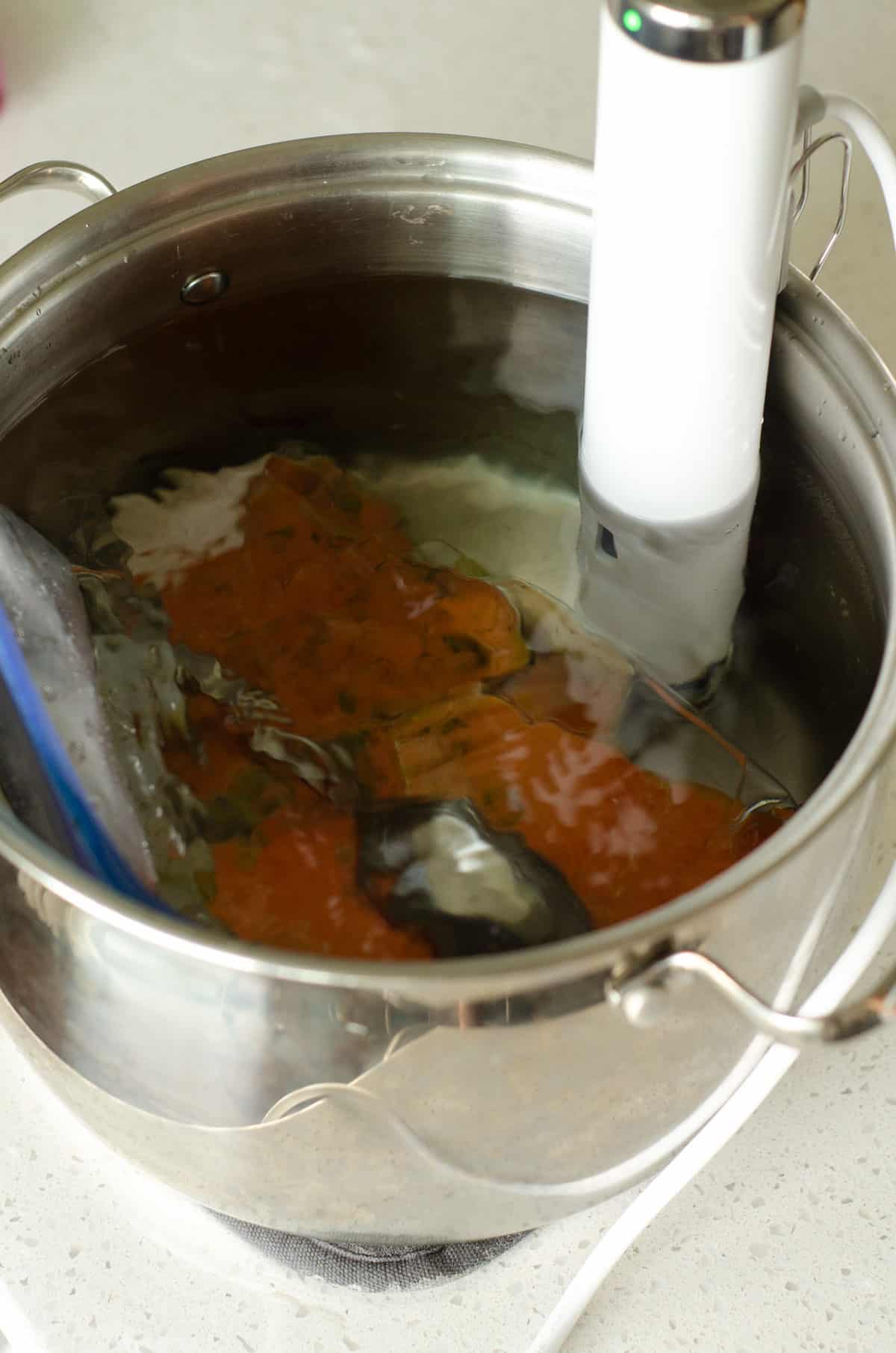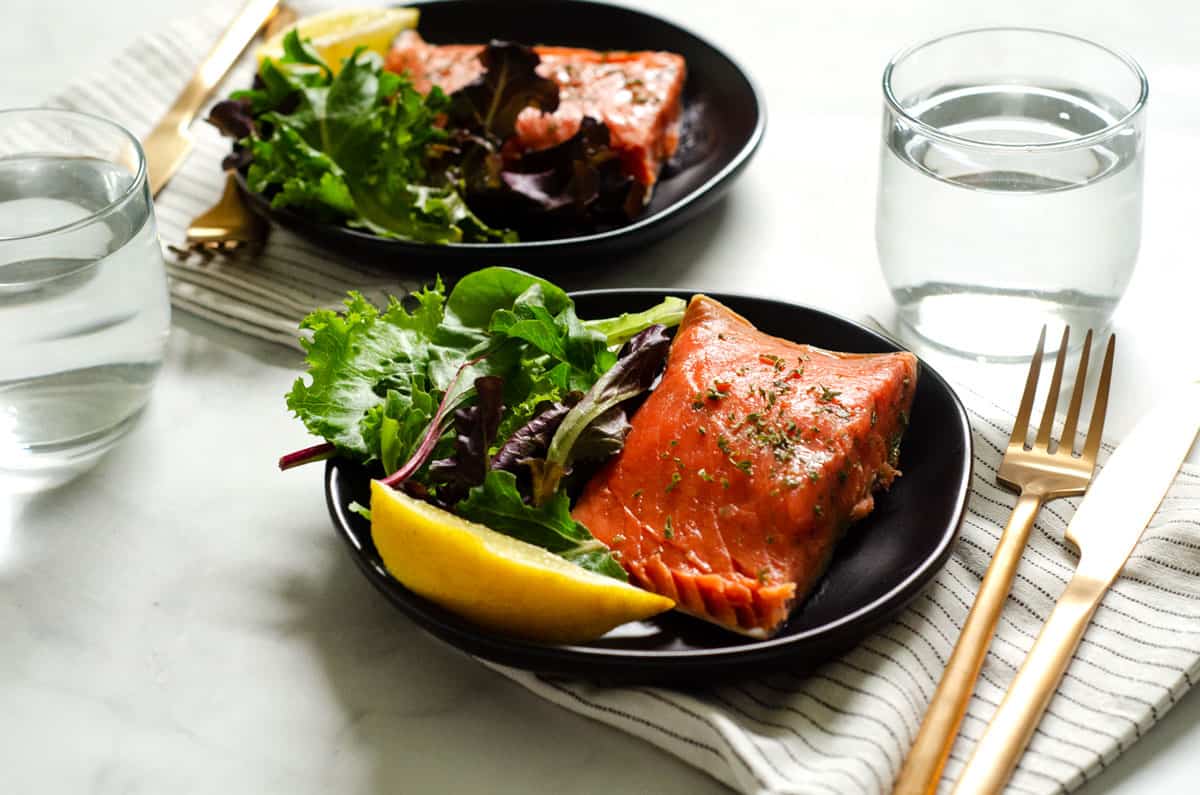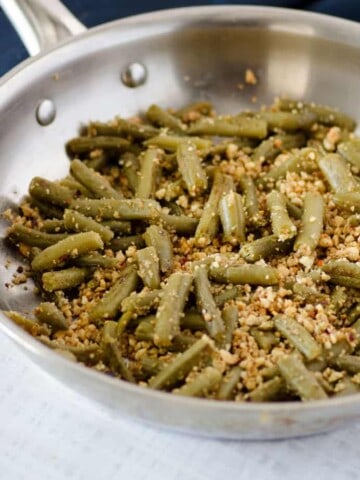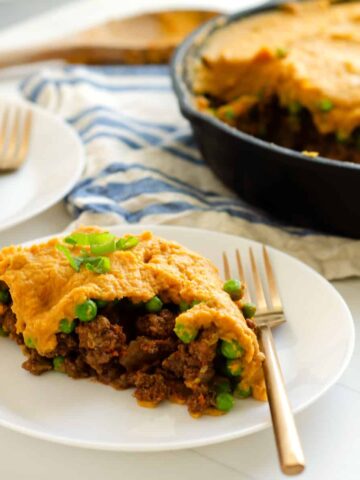This sous vide salmon recipe will leave you with a tender piece of fish, cooked to perfection. Even the novice cook can use the sous vide method of cooking to make perfectly cooked fish.
The sous vide process is so simple, you can add this to your list of easy recipes for a busy weeknight!
What is sous vide cooking
Traditional methods of cooking fish can often leave you with a dried out filet. Sous vide cooking is a method of cooking food in a water bath at a precise temperature.
You place the food you are planning to cook in a sous vide bag (or, if you're like me, you use a ziplock bag, because you are fancy enough to have a sous vide, but not fancy enough for a special sous vide bag) and seal it up, then place it in the water bath that is pre-heated for a designated amount of time until the food is cooked.
The sous vide machine is placed into the pot of water and brings the water to a pre-designated temperature. The water temperature is dependent on what you are cooking and how much you want it cooked.

A low temperature will leave you with more tender or undercooked food; higher temperatures will leave you with a more thoroughly cooked food. One isn't necessarily better than the other; it just depends on what you're cooking.
In sous vide cooking, the food is being brought to the same temperature as the water over a period of time. Once it reaches that temperature, the sous vide will continue to circulate it and "hold" it until you're ready to take it out.
This is the ultimate precision cooker!

I have the Joule sous vide . I just use a large stockpot, but if you fancy it, you can even purchase a special "sous vide" cooking container - which is really just a plastic bucket with a hinge lid.
The other very popular sous vide is the Anova sous vide. This is a much more friendly price point if you're just getting started with sous vide cooking. The other major difference is that the Joule uses an app on your phone to control it, while the Anova has a display directly on the sous vide itself.
Starting your sous vide
You'll start with a pot of cold water. You want to put this on your kitchen counter, but remember that you are cooking, so the pot is going to get hot!
When filling the pot, keep in mind the water displacement method - when you put the food in, the water will rise, so you'll need to leave enough room for that to happen without the pot overflowing.
Next, put something down on your kitchen counter to protect it - I have seen some people use a double layer of paper towels; I personally just fold a dish towel in half or use a pot holder. Whatever strikes your fancy; just be sure to put something underneath it.
Your cook time and cooking temperature are again, going to vary depending on the amount of doneness you want. You'll find a full chart below in the "Cooking your Sous Vide Salmon" section to determine your correct time and temp.
For salmon filets, use the following:
104° - soft and buttery
113° - delicate and juicy
122° - tender and flaky
131° - piecey and firm
You want to find the sweet spot for you. Remember everyone's tastes are different, so some may like theirs slightly undercooked while others may want it cooked longer.
We prefer the soft and buttery, but we realize that is not for everyone!
Prepping your salmon filets
You can cook your salmon fillets from either fresh or frozen! The sous vide will do the work for you.
You want to try and eliminate air from the bag. Some people like to use a vacuum sealer to get all the air out. I honestly just put my piece of salmon into a resealable plastic bag with olive oil and whatever seasonings I want to add to it, and push the air out before I seal it. I don't feel like much air is left in the bag, and it cooks just fine.

With salmon, I love to include a bit of lemon juice and some seasonings. I've seen other recipes that include soy sauce, brown sugar, and other strong flavors. Personally, I feel that the sous vide salmon really shines with less, not more, and so I keep mine pretty simple.
Cooking your sous vide salmon
Honestly, the sous vide does most of the work for you.
If you have the Joule, you'll see a red light while the water is heating, and a green light when the water is ready:

You'll place your bag into the preheated water and hit the start button - depending on your sous vide this might be in an app or on the actual tool.
The reason you want no air in the bag is because you need the bag to be completely submerged. If there is air in the bag, you might see it floating to the top. My favorite trick to eliminate this issue is to just put a spoon in the bag so it will sink!

You can also put a glass on top of it in the pot, which will weigh it down. Whatever you need to do to get it to get under there!
Cooking times are listed below for both fresh and frozen salmon. Frozen salmon cooks for a bit longer, for obvious reasons. But if you forgot to defrost your fish, no worries! You can still cook it up for dinner.
| Fresh | Frozen | |
| ½ inch | 30 minutes | 45 minutes |
| 1 inch | 40 minutes | 1 hour 10 minutes |
| 1 ½ inch | 1 hour | 1 hour 30 minutes |
Finishing your sous vide salmon recipe
Your salmon will be super tender and flaky when you take it out of the sous vide. However, some people like to finish it off with a quick sear in a pan to get a crispy salmon skin while keeping that flaky fish!
When you take it out, you're going to heat a pan over medium-high heat and quickly place the salmon skin side down into the pan. I prefer a cast iron skillet, as I think it's the best way to get a quick sear.
Serving your sous vide salmon

Pro Tip
Depending on where you get your salmon, you may want to remind your guests to watch out for the possibility of pin bones. These are tiny, thin bones that can be hard to see when eating but can be painful if swallowed!
Storing your salmon
One of my favorite things about sous vide salmon is how well it keeps. I tend to cook mine to one of the lower temperatures, so when I need to go back and reheat it, it's not getting over cooked.
Just store it in an airtight container in the fridge, and use it within 4-5 days after cooking. You can even just serve it cold on top of a salad and not have to reheat it!

What to serve with sous vide salmon
This salmon is simple and flavorful all on its own, but you probably need a side dish or two, yes?
A small mixed green salad pairs well, but might leave you a little hungry. Here are some healthy sides we love to serve this with:
Recipe

Sous Vide Salmon
This sous vide salmon recipe will leave you with a tender piece of fish, cooked to perfection. Even the novice cook can use the sous vide method of cooking to make perfectly cooked fish.
Ingredients
- 14 ounces salmon filets
- 1 tablespoon olive oil
- 2 teaspoon lemon juice
- ½ teaspoon salt
- ½ teaspoon parsley
- ¼ teaspoon garlic powder
Instructions
- Fill a large pot with water and add the sous vide. Set the temperature according to the doneness you prefer; temperatures can be found in the recipe post or in the notes below.
- While the water preheats, rinse salmon filets and pat dry.
- Add oil, lemon juice and spices to a large plastic bag and mix to combine.
- Add the salmon filets to the bag and toss gently to coat.
- When the water is preheated, add the bag of salmon to the water. You may need to weigh it down!
- Allow to cook for the time necessary for the thickness of your salmon as well as if it is frozen or fresh. See recipe post for chart to determine correct time.
- Remove from water. If a skin sear is desired, heat a pan over medium high heat with a bit of oil and sear skin side down for 1-2 minutes.
- Remove from pan and serve immediately.
Notes
Remember to protect your work surface. The pot will get hot - you are cooking in it, after all! A pot holder or dishtowel under the pot will do the trick.
Cooking temperature will depend on how well done you like your fish:
104° - soft and buttery
113° - delicate and juicy
122° - tender and flaky
131° - piecey and firm
Recommended Products
As an Amazon Associate and member of other affiliate programs, I earn from qualifying purchases, at no additional cost to you. Thank you for your support!
Nutrition Information:
Yield: 2 Serving Size: 1Amount Per Serving: Calories: 471Total Fat: 31gSaturated Fat: 6gTrans Fat: 0gUnsaturated Fat: 23gCholesterol: 125mgSodium: 704mgCarbohydrates: 1gFiber: 0gSugar: 0gProtein: 44g
I may earn a small commission off purchases made through affiliate links in this post from Amazon and other sellers. This helps me continue to run the blog and keep providing you fresh content. Thank you for your support!











Leave a Reply